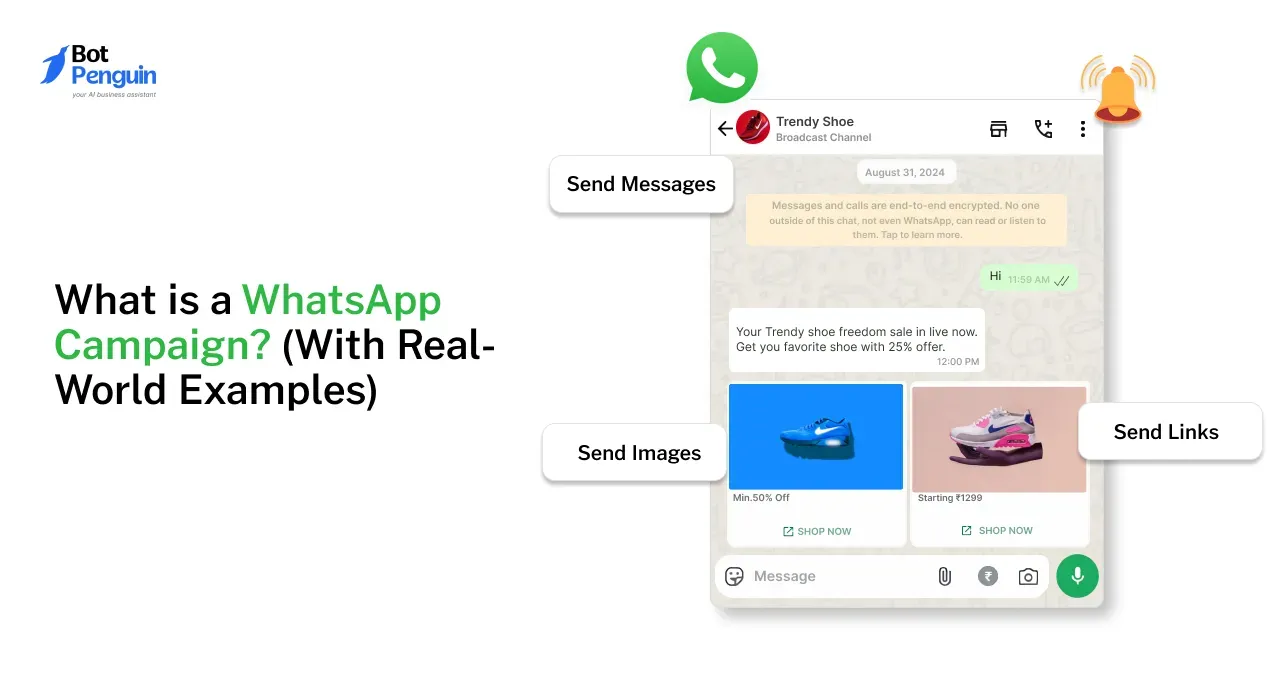Introduction
Are you ready to supercharge your projects with the power of AI? Enter Custom GPT, your secret weapon for tailored, high-performance solutions!
With a staggering 80% of businesses planning to integrate AI into their operations by 2025, according to a report from Gartner, it's clear that the future is all about personalization.
Custom GPT allows you to create AI models that fit your unique needs like a glove, enhancing everything from customer service to content creation.
Imagine having a digital assistant that not only understands your business goals but also learns and adapts to them over time! This article dives into the essential tips for effectively implementing Custom GPT in your projects.
Get ready to transform your workflows, boost productivity, and engage your users like never before. Let’s explore how to harness the true potential of Custom GPT and make your projects shine in the ever-evolving landscape of AI technology!
What is Custom GPT?
Custom GPT refers to a tailored version of the Generalized Pre-trained Transformer (GPT) model specifically designed to meet the unique requirements of particular tasks or industries.
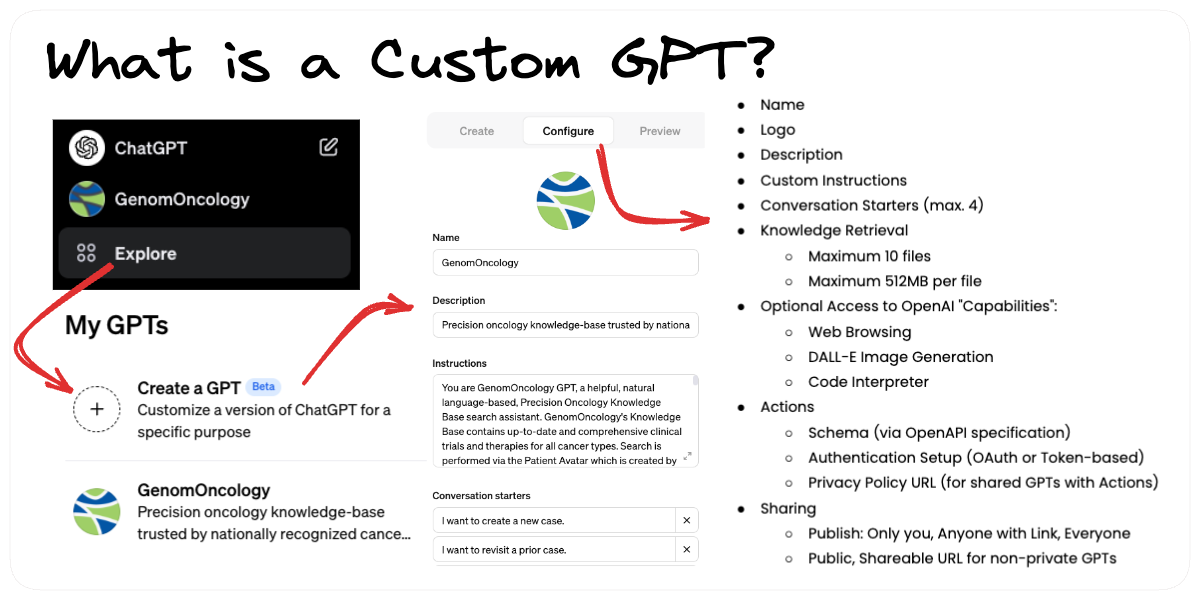
Unlike standard GPT models that take a broad approach, implementing Custom GPT allows you to address specific customer needs and business objectives effectively.
Differences Between Standard GPT and Custom GPT
The key distinction between standard GPT and Custom GPT lies in adaptability. While standard GPT models are trained on a wide array of data, they may not fully align with specific goals.
In contrast, when you choose to create Custom GPT, you can fine-tune it with relevant datasets tailored to your particular tasks—be it customer service, content generation, or any other function.
Common Use Cases for Custom GPT
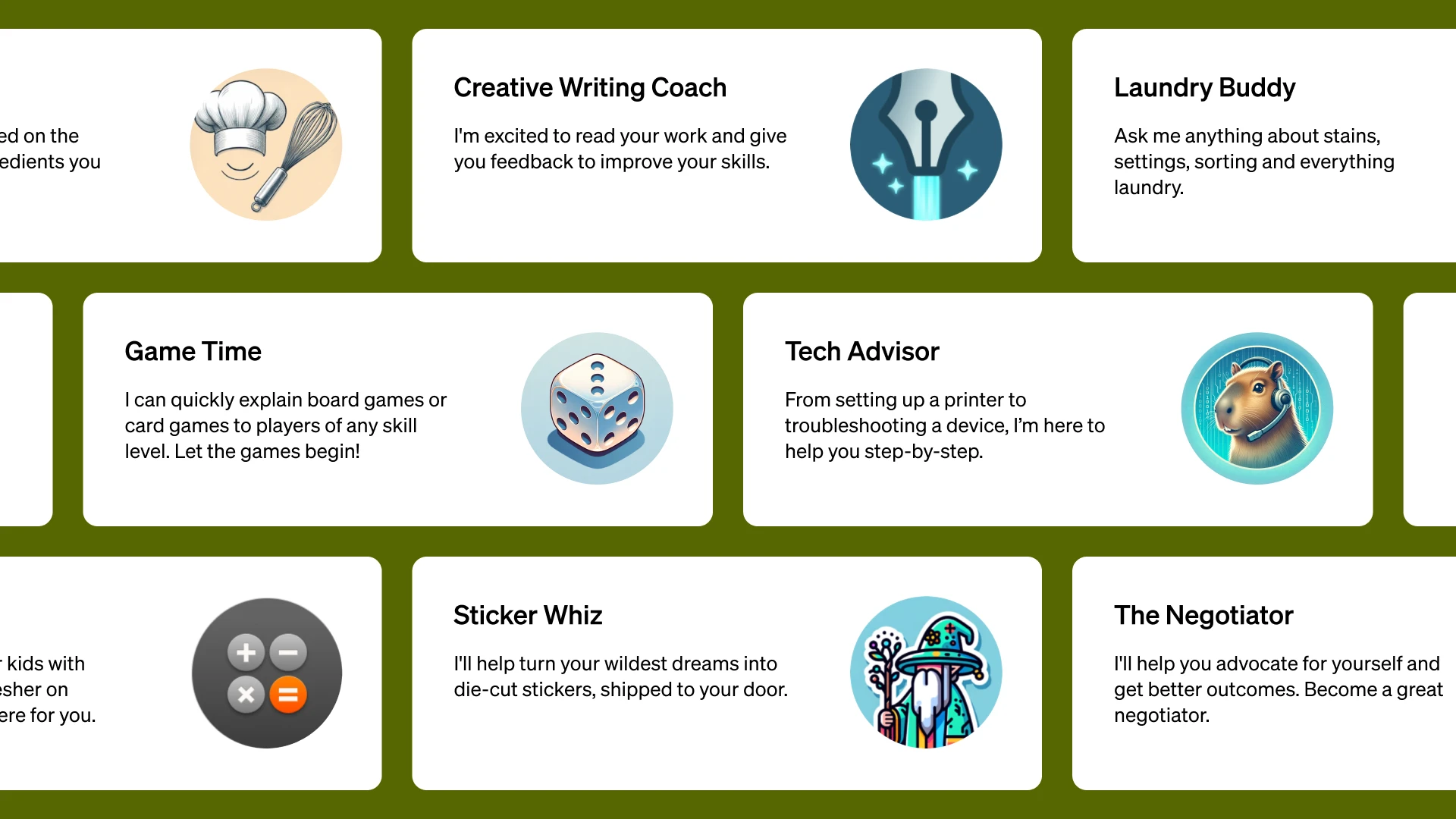
Following are some of the most common use cases for Custom GPT :
- Customer Service: Automating responses and managing queries effectively can elevate customer satisfaction. For instance, many e-commerce platforms are now utilizing Custom GPT to handle FAQs, providing immediate support without human intervention
- E-commerce: By personalizing shopping experiences, Custom GPT enhances customer engagement. Imagine a retail website that employs a Custom GPT model to recommend products based on user behavior and preferences, significantly boosting conversion rates.
- Healthcare: Offering health advice and addressing medical inquiries are critical areas where Custom GPT can shine. For example, a telehealth service can utilize a Custom GPT model to provide immediate, reliable answers to patients, thereby improving accessibility and patient satisfaction.
Benefits of Using Custom GPT in Projects
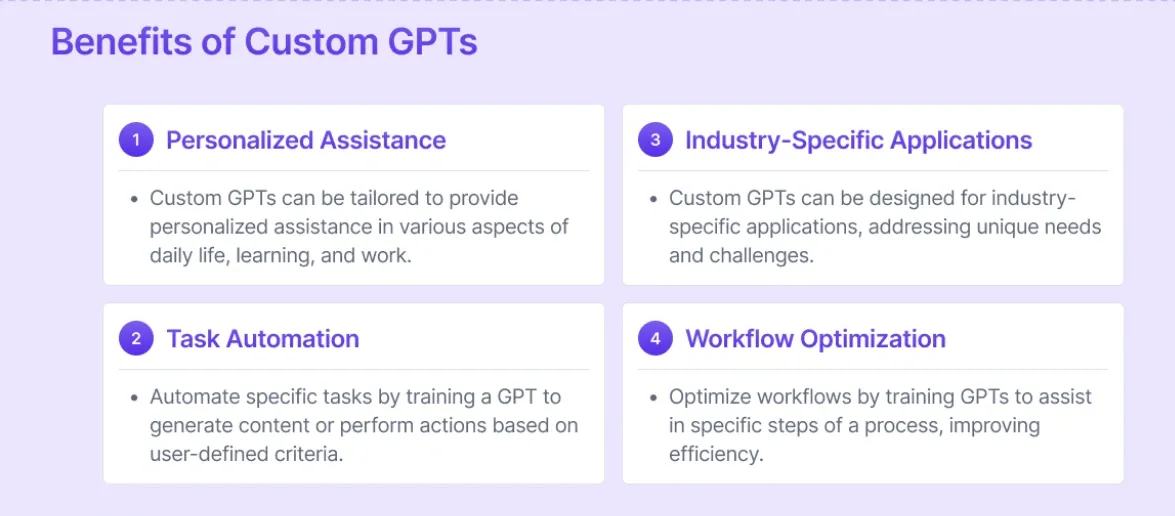
When you implement Custom GPT, you unlock a model that is not only efficient but also highly aligned with your strategic objectives. Here are several benefits:
- Tailored Solutions: Custom GPT can be fine-tuned to meet specific project needs, providing personalized solutions for tasks like customer service, content generation, or automation.
- Improved Efficiency: By automating repetitive tasks, Custom GPT reduces manual effort and saves time, leading to enhanced overall productivity.
- Scalability: This model can easily scale to handle increasing workloads, making it ideal for projects that experience growth over time.
- Cost-Effectiveness: By lowering the need for human resources in routine tasks, implementing Custom GPT can significantly cut operational costs.
- Real-Time Interaction: Custom GPT supports real-time communication with users, improving the responsiveness of your project and leading to higher customer satisfaction.
- Seamless Integration: You can integrate Custom GPT with existing systems and tools, ensuring a smooth workflow and minimizing disruptions.
- Continuous Learning: Custom GPT models evolve over time as they are retrained with new data, ensuring they remain relevant and effective.
Expert Tips for Using Custom GPT in Your Projects
Implementing Custom GPT into your project can unlock personalized and powerful AI-driven capabilities, offering tailored solutions that enhance various workflows.
This guide shares expert tips for using Custom GPT in your projects, covering everything from setting clear objectives to managing costs effectively.
Define Clear Objectives
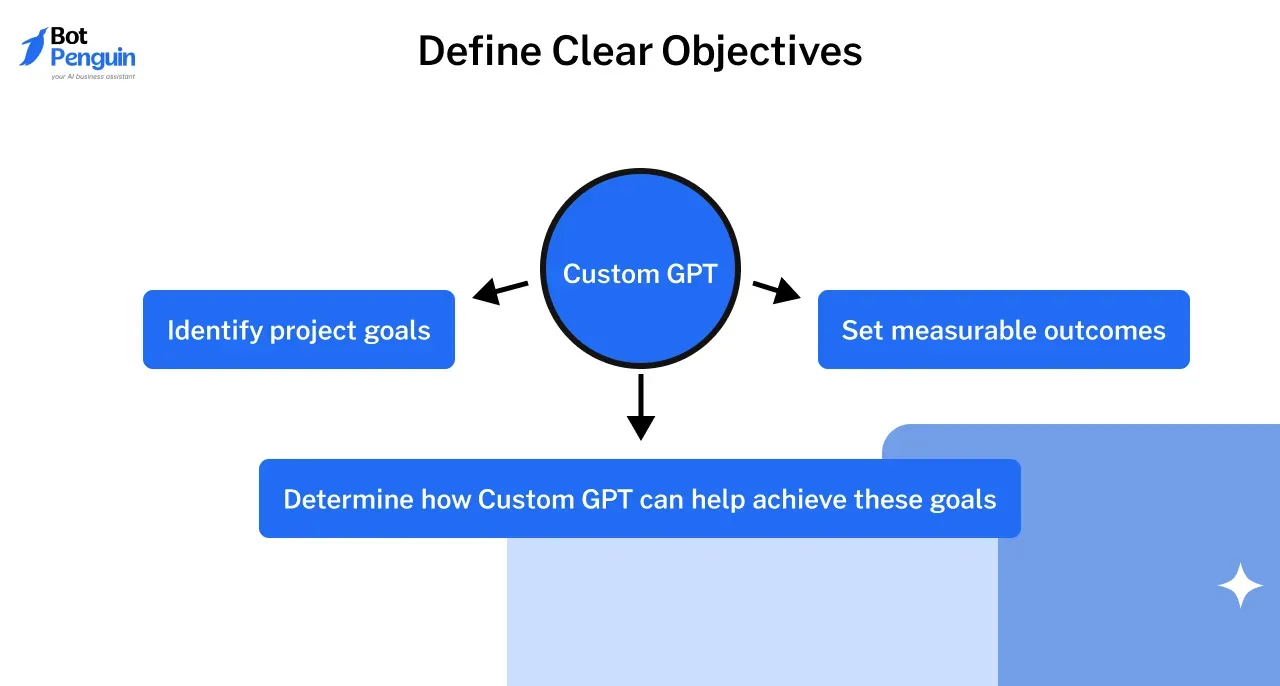
Before diving into the implementation of Custom GPT, it’s vital to establish clear objectives.
- Identify project goals: Begin by outlining your primary objectives. Whether it’s automating customer support, generating high-quality content, or improving user engagement, having specific goals will streamline the implementation process.
- Determine how Custom GPT can help achieve these goals: Assess how Custom GPT can cater to your specific needs after defining your objectives.
For instance, Custom GPT can be fine-tuned for tasks like customer service, marketing automation, or personalized product recommendations.
- Set measurable outcomes: Establish indicators to measure success. Whether it's improved response times or enhanced customer satisfaction, tracking these metrics will enable you to evaluate your Custom GPT model’s effectiveness over time.
Data Preparation

High-quality data is paramount for building an effective Custom GPT model.
- Collect relevant data: Focus on gathering data aligned with your project’s goals. This may include customer conversations, relevant articles, or user queries that can train the model to meet your specific needs.
- Clean and organize data for training: Ensure that your dataset is free from irrelevant or erroneous information. Organizing it in a structured format will streamline the training process and improve overall outcomes.
- Ensure data quality and diversity: A diverse dataset leads to a more versatile Custom GPT model. Incorporate a wide range of examples to ensure the model can handle various user inputs and situations effectively.
Choosing the Right Model
Selecting the appropriate GPT model for your project is crucial for balancing performance and resource usage.
- Overview of available GPT models: There are several versions of GPT available, such as GPT-3, GPT-3.5, and GPT-4, each varying in complexity and capabilities.
- Selecting a model based on project needs: Depending on the complexity of your project, choose the model that best aligns with your goals.
For example, GPT-4 is ideal for handling intricate tasks, while GPT-3 might be sufficient for simpler applications.
- Balancing performance and resource requirements: More advanced models offer better functionality but also require greater resources.
Ensure the model you select provides an optimal balance between performance and cost, especially if you plan to scale up your usage.
Training Your Custom GPT
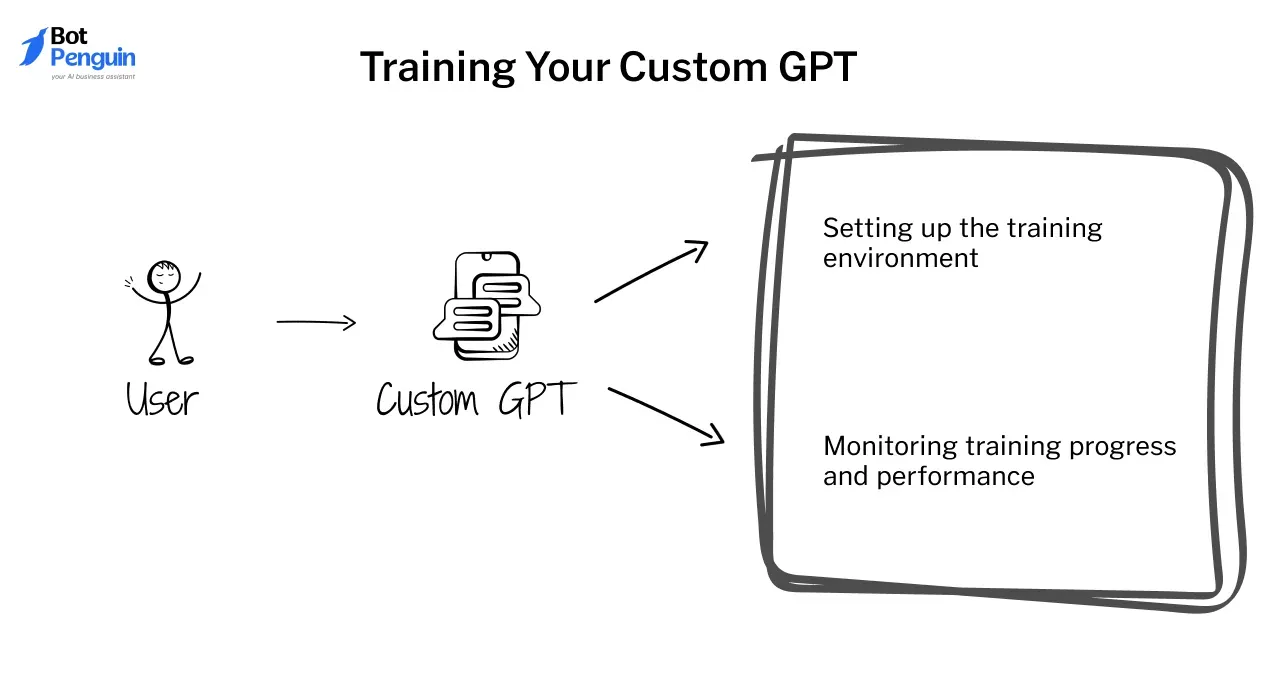
Once your data and model are in place, the next critical step is training your Custom GPT.
- Setting up the training environment: Begin by establishing a suitable training environment. Platforms like OpenAI Custom GPT simplify this process by offering robust infrastructure for training your model effectively.
- Monitoring training progress and performance: During the training phase, monitor the model’s progress and performance metrics.
This will allow you to make necessary adjustments, such as tweaking learning rates or refining the dataset for better outcomes.
Integration into Your Project
Integrating your Custom GPT into your system is a critical step that requires careful planning to ensure smooth functionality.
- APIs and tools for integration: Leverage the APIs provided by OpenAI Custom GPT for seamless integration with your project's platforms.
This approach allows the model to operate effectively within your existing infrastructure, ensuring that it meets your specific project requirements.
- Ensuring seamless interaction with existing systems: It’s essential to ensure that the Custom GPT model communicates effectively with your current systems, such as CRM tools or content management platforms.
For example, integrating Custom GPT into a customer support CRM can automate responses and streamline workflows, improving overall efficiency.
- Testing the integration thoroughly: Before fully deploying the Custom GPT, conduct thorough testing to identify any bugs or compatibility issues.
This step is crucial to ensure that the model operates as intended, thereby minimizing disruptions when it is launched into production.
Optimizing Performance
To get the most out of your Custom GPT, optimization is essential to ensure top-notch performance.
- Techniques for improving response quality: Adjust model parameters such as response length and temperature to enhance the quality of replies.
For instance, fine-tuning these settings can significantly improve the relevance and clarity of the model’s outputs, making interactions more meaningful for users.
- Managing resource usage effectively: Monitor resource consumption to prevent your Custom GPT model from overloading system resources.
Implementing efficient resource management strategies will ensure the model runs smoothly without sacrificing performance, helping to keep operational costs low.
Ensuring Security and Privacy
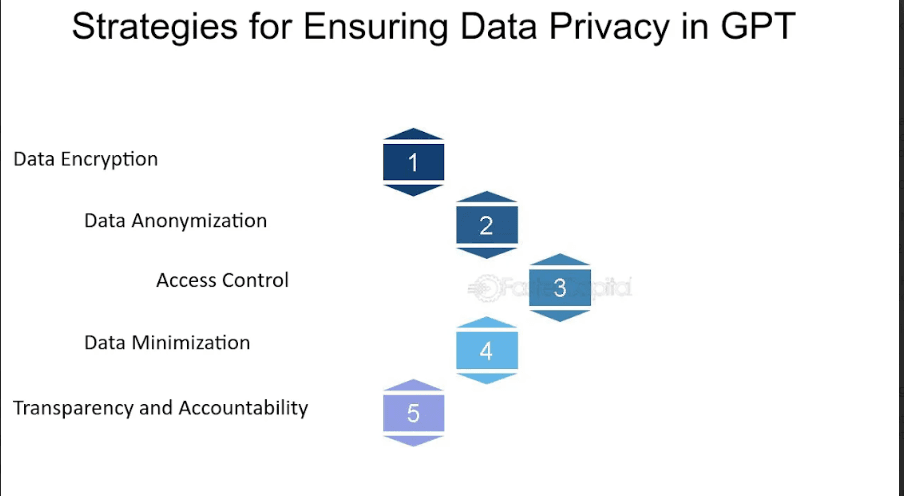
Security and privacy are paramount when working with AI models, especially in sensitive sectors like healthcare or finance.
- Protecting sensitive data: Encrypt all data during transmission and storage to safeguard sensitive information processed by the Custom GPT model.
This practice is vital for maintaining user trust and ensuring compliance with data protection regulations.
- Implementing access controls: Restrict access to the Custom GPT system to authorized personnel only. This measure helps prevent unauthorized individuals from tampering with or accessing sensitive data, thus enhancing security.
- Complying with data protection regulations: Ensure that your project adheres to data protection laws such as GDPR or HIPAA when handling personal or sensitive information.
By maintaining compliance, you can avoid legal issues and bolster your reputation.
User Experience Design
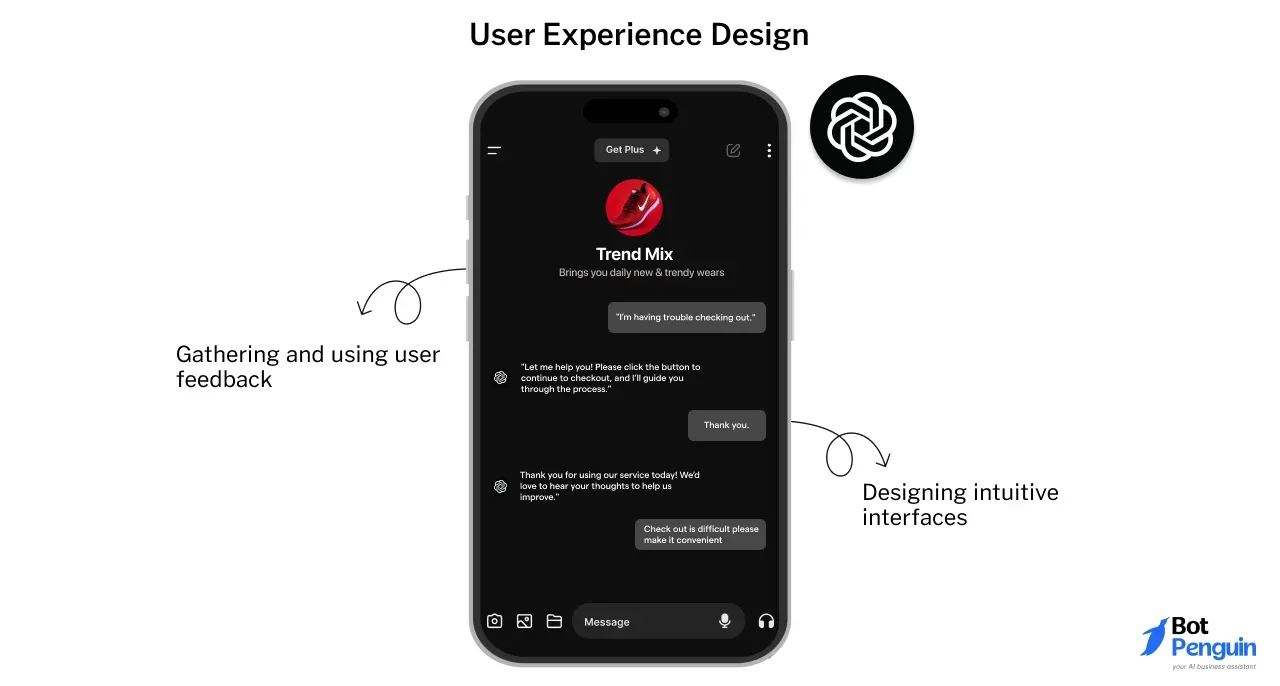
Creating a positive user experience is essential for maximizing the impact of your Custom GPT model.
- Designing intuitive interfaces: Users should be able to interact with the Custom GPT easily and efficiently. Keeping the interface simple, intuitive, and user-friendly will ensure smooth interactions, leading to higher user satisfaction.
- Gathering and using user feedback: Continuously collect user feedback to refine the model. Analyzing this feedback will help you identify pain points and areas for improvement, ensuring the model evolves to meet user needs and expectations.
Maintenance and Updates
To keep your Custom GPT model effective over time, regular maintenance and updates are necessary.
- Regularly updating the model with new data: The relevance of the model's output increases with the recency of its data.
Regularly updating the dataset will help reflect changes in user behavior or industry trends, keeping your Custom GPT aligned with current demands
- Addressing issues and making improvements: Regular monitoring will enable you to identify and rectify issues before they affect performance.
Continuous improvement efforts will ensure that your Custom GPT model remains up-to-date and effective in meeting user needs.
Troubleshooting Common Issues
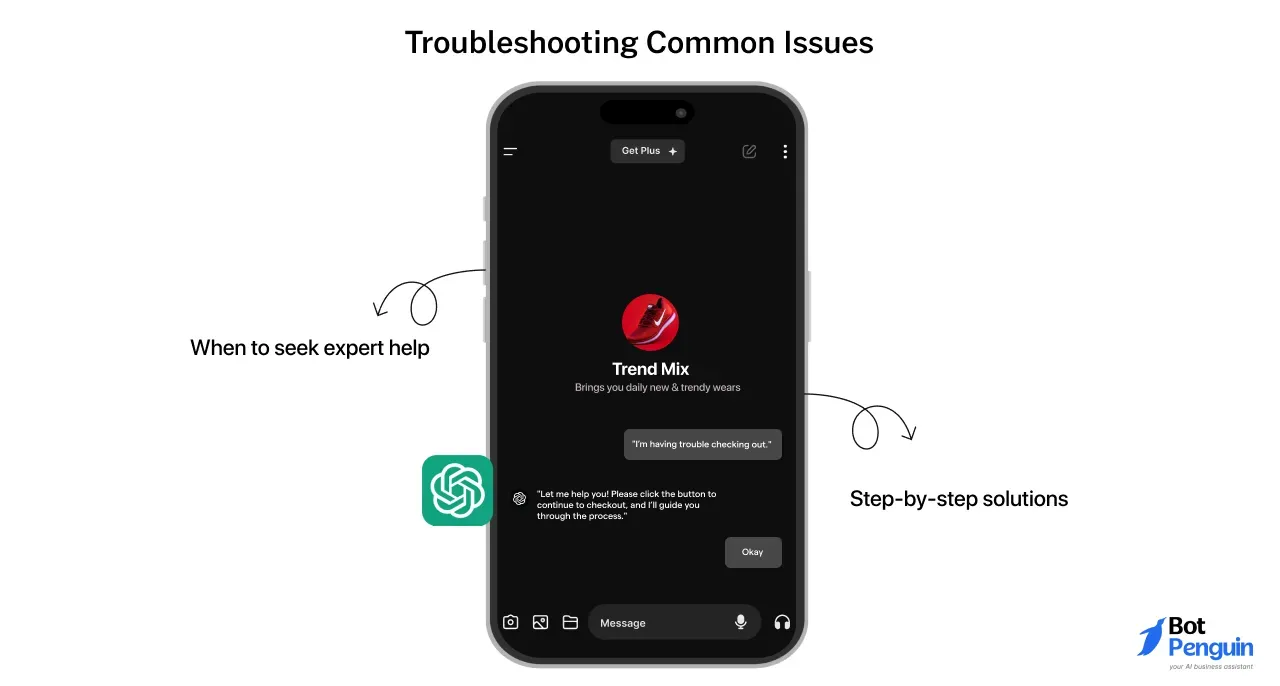
While implementing Custom GPT, you may encounter challenges. Here’s how to troubleshoot common problems effectively.
- Identifying common problems: Common issues may include inaccuracies in responses, slow response times, or data processing errors.
Quickly identifying the root cause will help minimize disruptions and enhance user experience.
- Step-by-step solutions: Develop a clear set of troubleshooting steps to resolve common issues. This may involve adjusting the training dataset, fine-tuning the model’s parameters, or reviewing the API integration to ensure everything works smoothly.
- When to seek expert help: If problems persist or are too complex to resolve in-house, consider consulting AI experts for advanced troubleshooting and solutions.
Their expertise can be invaluable in optimizing your Custom GPT's performance and functionality.
Cost Management
Managing the costs associated with implementing Custom GPT is essential, especially for larger projects.
Careful financial planning can help ensure that your project remains within budget while maximizing its potential.
Strategies to minimize expenses:
Implement strategies such as reducing training time, limiting unnecessary API calls, and optimizing server loads to lower operating costs.
For instance, selecting an appropriate model size can significantly reduce expenses while still maintaining optimal performance. This approach helps you achieve your project goals without overspending.
Maximizing ROI:
Custom GPT can provide a significant return on investment by automating repetitive tasks, enhancing user interactions, and increasing overall efficiency.
By leveraging these capabilities, you can streamline operations and free up resources for more strategic initiatives, ultimately boosting your project's profitability.
Conclusion
Implementing Custom GPT in your projects can transform the way you approach tasks and interact with users, offering tailored solutions that drive efficiency and engagement.
By carefully defining your objectives, preparing high-quality data, and choosing the right model, you set the foundation for success.
Optimization, integration, and a focus on user experience are crucial steps to ensure that your Custom GPT delivers exceptional performance.
Additionally, managing costs effectively will help you maximize your return on investment, making your project financially sustainable. With continuous updates and a commitment to addressing common challenges, your Custom GPT can evolve to meet changing needs and maintain its effectiveness over time.
Embrace the potential of Custom GPT, and unlock innovative solutions that not only enhance your workflows but also create a lasting impact on your business outcomes.
Whether you're looking to automate tasks or improve customer engagement, Custom GPT is your gateway to AI-driven excellence.
Frequently Asked Questions (FAQs)
What is the main advantage of using Custom GPT in projects?
Custom GPT provides tailored AI solutions that align precisely with your unique needs, resulting in outputs that are more accurate, relevant, and context-aware.
How do I implement Custom GPT in my project?
To implement Custom GPT effectively, start by defining clear objectives and outcomes you wish to achieve. Next, gather and fine-tune a GPT model using relevant and high-quality data.
Utilize platforms like OpenAI’s API, which offers user-friendly interfaces to customize and deploy the model according to your project needs.
What are common use cases for Custom GPT?
Custom GPT is versatile and widely used across various sectors. Common applications include automating customer service through intelligent chatbots, generating high-quality content for blogs and marketing, enhancing user interactions via personalized recommendations, and conducting specialized data analysis for insights.
Do I need technical expertise to create Custom GPT models?
While having technical expertise can be beneficial, it’s not a strict requirement. Many platforms, including OpenAI, provide user-friendly tools and documentation that simplify the customization process.
How do I optimize data for fine-tuning Custom GPT?
Optimizing data for fine-tuning is critical to achieving accurate model performance. Ensure that your dataset is clean, relevant, and well-structured, removing any noise or inconsistencies. C
Is it expensive to maintain Custom GPT models?
Maintenance costs for Custom GPT models can vary based on usage and complexity. However, you can effectively manage expenses by optimizing your model's performance and resource usage.
Strategies such as model compression, efficient API usage, and selective data processing can help balance costs and performance.

